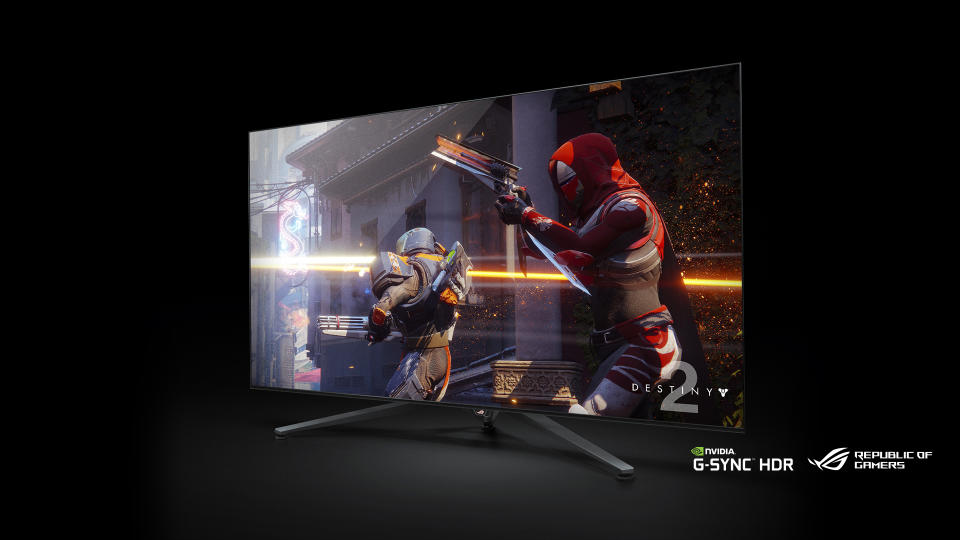Nvidia went all out for PC gaming at CES 2018
Nvidia (NVDA) might be making big news at CES 2018 thanks to its artificial intelligence and self-driving car technologies, but the company originally started out by building PC graphics cards. And despite all of its recent success, it’s not leaving those roots behind.
In fact, it’s pushing them forward with a number of new products ranging from cloud gaming to enormous PC displays and super-thin laptops. It’s an impressive display of gaming power, and likely to drain players’ wallets in the year ahead.
Cloud streaming
Nvidia has been working on cloud gaming technology, the ability to stream and play games at their highest settings from high-powered servers to anything from the best laptop to a 5-year-old hunk of junk, for some time now. The company already offers a cloud streaming service for Apple’s Mac, called GeForce Now as a free beta for some time. And now, it’s bringing the platform to PCs.

Cloud gaming is the holy grail of PC gaming, but it’s never taken off due to the fact that companies need to allocate an enormous amount of resources to run games for thousands of players trying to run different titles at the exact same time.
To deal with that, Nvidia, and others like it, have to build out data centers that can not only handle the load of all of those gamers playing at once, but locate those data centers in areas across the country to ensure players don’t experience any noticeable latency while they game.
It’s a lot of work, and Nvidia doesn’t quite know when the service will be available to the general public, or how much it will cost, but if the company can keep it affordable and easy to use, it could have a huge impact on the gaming industry.
A bigger screen for games
You want a giant gaming display? Well, Nvidia is bringing it to you. The company showed off three of its upcoming BFG-D screens or Big Format Gaming Displays and they are absolutely stunning. BFG, by the way, stands for Big F-ing Gun in the game “Doom,” which is why when Nvidia CEO Jensen Huang announced the screens during the company’s keynote, he made sure to emphasize the initials.
The screens, which can’t be called televisions because they don’t include TV tuners, run 4K resolutions at 120Hz, offer HDR color with a brightness of 1,000 nits. Nvidia showed off the screens by displaying a non-HDR image followed by an HDR version of the same shot, and the results were stunning. Colors popped and looked far more natural in the HDR version than the standard image.

What’s more, Nvidia has equipped the screens with its G-Sync technology, which ensures that the display and content you’re playing or watching are running at the same refresh rate. That’s important, because it means you won’t see the kind of tearing that occurs during games when your content is moving faster than the display can refresh.
Nvidia isn’t the one selling the BFG-Ds, though. Instead, Acer, ASUS and HP will be selling the screens under their own branding. Each version of the panels will look the same, though the companies will add their own types of speakers, designs and software to the mix. There’s no word on pricing for the BFG-Ds, but you can expect them in the second half of 2018.
GeForce Experience and Max-Q laptops
Nvidia’s GeForce Experience software is a suite of programs that allow you to do things like take 3-D screenshots of your favorite games, easily download and install drivers for your Nvidia graphics card and share your game replays with your social networks.
At CES 2018 the company is updating the software with its Freestyle feature. Freestyle allows you to customize your game’s visuals using a series of filters and effects that change the color and sharpness of images.
The software also includes filters that you can lay on top of your game. One filter Nvidia showed off while playing “Call of Duty: WWII” made the game look like an old black and white movie, complete with film tears. It’s a slick feature for gamers who prefer to make their games look just the way they want.
Nvidia also shined a spotlight on its Max-Q laptop design philosophy. Max-Q isn’t exactly new — companies have been shipping models that take advantage of the style for months — but Nvidia seems to want to put a greater emphasis on its role in the construction of such notebooks.
Max-Q isn’t a specific laptop, nor does it necessarily serve as a designation for the graphics chip a laptop uses. Instead, it’s how Nvidia refers to laptops that use high-end graphics chips while maintaining relatively thin bodies.
It’s not a particularly helpful descriptor, but what it means is you’ll get a very thin laptop with the kind of horsepower you’d expect from a much thicker system. Sure enough, I played with a handful of Max-Q-style laptops and they managed to push some of today’s biggest games at their highest graphics settings without breaking a sweat.
The idea is to prove that just because you want to game on a laptop doesn’t mean you have to buy a notebook as thick as an old VCR. After all, most modern gaming laptops aren’t exactly portable. But by outfitting notebooks with powerful graphics chips and processors, Nvidia hopes consumers who have been putting off buying a gaming computer because they only have space for a notebook will make the jump to becoming full-fledged gamers.
More from Dan:
Email Daniel Howley at [email protected]; follow him on Twitter at @DanielHowley.
